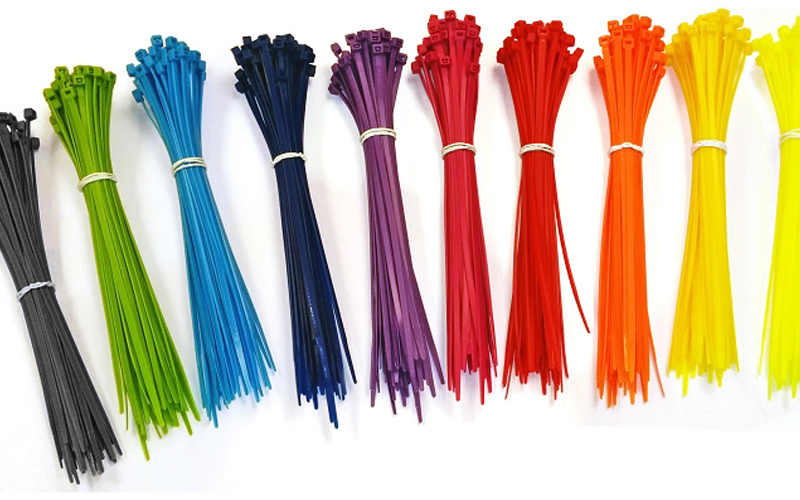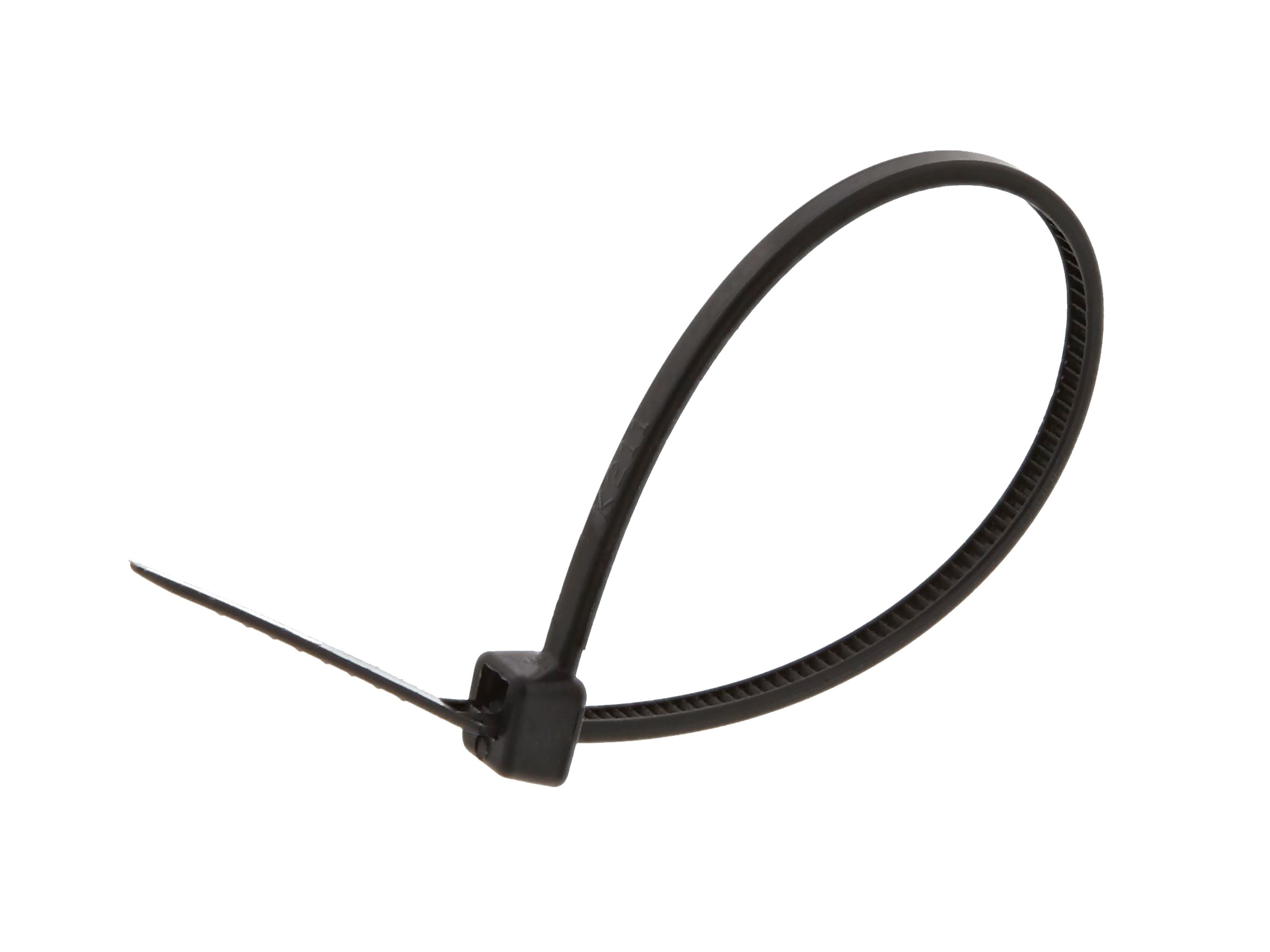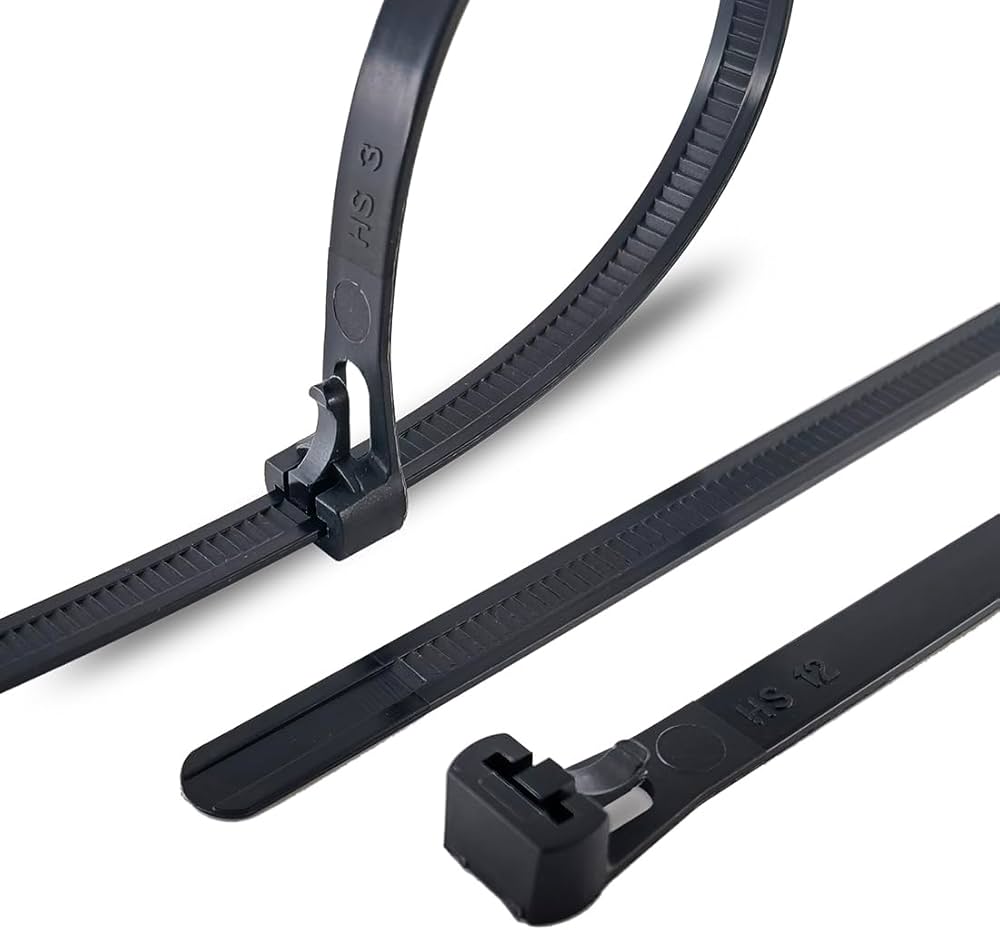Cable ties are versatile fasteners used for bundling and securing cables or objects. They are essential in various industries and applications.
Cable ties, also known as zip ties, are indispensable tools for organizing and securing items. These simple yet effective fasteners come in different sizes, colors, and materials to suit diverse needs. Their primary use is in managing cables and wires, ensuring a neat and tidy setup.
They also find applications in gardening, home improvement projects, and even in creative DIY crafts. With their self-locking mechanism, cable ties provide a secure hold, making them a reliable choice for both temporary and permanent solutions. Their ease of use and affordability make them a staple in homes, offices, and industrial settings alike.
Introduction To Cable Ties
Cable ties are essential tools used in various industries. They help bundle and secure wires and cables. Their simplicity and effectiveness make them popular. Understanding their origin and components can be fascinating.
Origin And History
Cable ties were invented in 1958 by Thomas & Betts. The initial design was for airplane wiring. Early cable ties were made of metal. Over time, plastic became the preferred material. This change made them cheaper and easier to use. The original name was “Ty-Rap.” Today, they are known simply as cable ties.
Basic Components
Cable ties consist of a flexible tape and a locking mechanism. The tape has teeth along one side. These teeth engage with the locking mechanism. The locking head secures the tape in place. Cable ties are typically made from nylon.
Here are the basic components of a cable tie:
- Flexible Tape: The long, strip-like part with teeth.
- Locking Head: The small square part that locks the tape.
Cable ties come in various sizes and colors. Each size suits different applications. For example, small ties are for electronics. Large ties are for heavy-duty tasks.
Below is a table showing common cable tie sizes and uses:
| Size | Length | Common Use |
|---|---|---|
| Small | 4 inches | Electronics |
| Medium | 8 inches | Home Improvement |
| Large | 14 inches | Industrial |
Cable ties are versatile and easy to use. They are indispensable in many fields. Their design has remained mostly unchanged, proving their effectiveness.

Credit: www.pinnaclepackaging.net
Types Of Cable Ties
Cable ties are essential tools in various industries. They help organize and secure cables, wires, and other items. Understanding the types of cable ties can help you choose the best one for your needs.
Standard Cable Ties
Standard cable ties are the most common type. They are versatile and used in many applications. These ties are made of nylon and come in various sizes and colors. They are easy to use and provide a strong hold. Here are some key features:
- Available in different lengths
- Single-use design
- High tensile strength
Standard cable ties are perfect for everyday tasks. They are reliable and affordable.
Releasable Cable Ties
Releasable cable ties are reusable. They have a special mechanism that allows them to be opened and closed multiple times. These ties are ideal for temporary projects. Key features include:
- Reusable design
- Easy to release and reuse
- Various sizes and colors
Releasable cable ties are great for situations where you need to adjust or remove ties frequently.
Heavy-duty Cable Ties
Heavy-duty cable ties are designed for demanding applications. They are made of stronger materials and can handle more weight. These ties are perfect for industrial use. Important features include:
- High tensile strength
- Resistant to harsh environments
- Available in extra-long lengths
Heavy-duty cable ties offer maximum durability and strength for tough jobs.
| Type | Key Features | Best For |
|---|---|---|
| Standard Cable Ties | Versatile, high tensile strength, single-use | Everyday tasks |
| Releasable Cable Ties | Reusable, easy to release, adjustable | Temporary projects |
| Heavy-Duty Cable Ties | High tensile strength, durable, extra-long lengths | Industrial use |
Materials Used
Understanding the materials used in cable ties is essential. Different materials offer various strengths and benefits. This section explores the common materials used in cable ties.
Nylon
Nylon cable ties are the most common. They are versatile and cost-effective. These ties offer strong resistance to wear and tear. They are also lightweight and flexible. Here are some key points about nylon cable ties:
- High tensile strength
- Good resistance to chemicals
- UV-resistant (UV-stabilized variants)
- Temperature range: -40°F to 185°F (-40°C to 85°C)
Stainless Steel
Stainless steel cable ties are ideal for demanding environments. They provide excellent durability and strength. These ties are resistant to extreme temperatures and corrosive elements. Key features of stainless steel cable ties include:
- High resistance to corrosion
- Non-flammable
- Temperature range: -112°F to 1000°F (-80°C to 538°C)
- Long-lasting performance
Specialty Materials
Some cable ties are made from specialty materials for specific applications. These materials include Tefzel, Polypropylene, and Halar. Each offers unique properties:
| Material | Key Features |
|---|---|
| Tefzel | High chemical resistance, temperature range: -50°F to 302°F (-45°C to 150°C) |
| Polypropylene | Good chemical resistance, lightweight, temperature range: -40°F to 185°F (-40°C to 85°C) |
| Halar | Flame retardant, high-temperature resistance, temperature range: -40°F to 302°F (-40°C to 150°C) |
Choosing the right material ensures the cable ties perform well. Each material has unique strengths and limitations. Understanding these can help in selecting the best option for your needs.
Common Applications
Cable ties are versatile and essential in many settings. They offer practical solutions for managing wires and organizing spaces. Here, we explore the common applications of cable ties in various environments.
Home And Office
Cable ties are excellent for keeping home and office spaces tidy. Use them to bundle cables behind desks, keeping workspaces clutter-free. They can also secure loose wires from electronic devices.
- Organize computer cables
- Secure TV and entertainment system wires
- Bundle kitchen appliance cords
- Manage extension cords and chargers
Industrial Uses
In industrial settings, cable ties are indispensable. They help in securing heavy cables and wires. They are also used in marking and labeling items.
- Bundle heavy machinery wires
- Label pipes and hoses
- Securely fasten cables in manufacturing plants
- Organize tools and equipment
Outdoor And Marine
Cable ties are perfect for outdoor and marine applications. Their durability and resistance to weather make them reliable.
- Secure garden hoses
- Bundle outdoor lighting cables
- Fasten boat ropes and equipment
- Attach gear in camping and hiking
Installation Techniques
Cable ties are essential for organizing and securing cables. Proper installation techniques ensure safety and efficiency. Here, we explore different methods for installing cable ties effectively.
Manual Installation
Manual installation is simple and requires no tools. Follow these steps:
- Wrap the cable tie around the cables.
- Insert the tail into the head of the tie.
- Pull the tail to tighten the tie.
- Ensure the tie is secure but not too tight.
Manual installation works best for small projects. It is quick and easy. Avoid over-tightening to prevent damage.
Using Tools
Tools make installation faster and more precise. Popular tools include:
- Cable Tie Guns: These tools tighten and cut the tie in one step.
- Tensioning Tools: They apply consistent tension, ideal for large projects.
Using tools provides a professional finish. Follow the tool’s instructions for best results. Tools reduce hand fatigue and improve efficiency.
Safety Tips
Safety is crucial during cable tie installation. Follow these tips:
- Wear gloves to protect your hands.
- Use safety goggles when cutting ties.
- Ensure ties are not too tight to avoid damaging cables.
- Cut excess tie tails to prevent injuries.
Keep your work area clean and organized. Proper safety measures prevent accidents and ensure a secure installation.

Credit: www.amazon.com
Innovative Uses
Cable ties are incredibly versatile tools. They’re not just for bundling wires. They can be used in innovative ways around the home and beyond. Here are some unique uses for cable ties that might surprise you.
Diy Projects
Cable ties can be a game-changer for many DIY projects.
- Build simple shelves by securing wooden planks together.
- Use them to create custom picture frames.
- Make a plant trellis for your garden.
They are strong and flexible. This makes them perfect for creative tasks. Plus, they are easy to use.
Creative Home Solutions
Cable ties offer creative solutions for household organization.
- Secure loose cords behind your TV.
- Hang holiday decorations without nails.
- Fix a loose toilet seat.
They can also help with storage. Bind together items like brooms and mops.
Emergency Repairs
Cable ties are essential for emergency repairs.
- Fix broken zippers on bags or clothing.
- Hold together broken car parts temporarily.
- Repair a broken bike chain in a pinch.
Keep a few cable ties in your emergency kit. They are small but mighty.
Environmental Impact
Cable ties are essential in various applications, but their environmental impact is significant. Understanding their environmental footprint helps us make better choices.
Biodegradable Options
Traditional cable ties are made from plastic, which harms the environment. Biodegradable cable ties are now available. These ties break down naturally over time, reducing waste. They are made from materials like polylactic acid (PLA). PLA is derived from renewable resources such as corn starch or sugarcane.
Switching to biodegradable options helps decrease plastic pollution. It is a simple yet effective step towards a greener planet.
Recycling And Disposal
Recycling plastic cable ties is challenging. Their small size makes them hard to process. Many recycling facilities do not accept them. Disposal of cable ties often leads to landfill accumulation. This contributes to long-term environmental harm. Proper disposal involves cutting ties into smaller pieces to reduce bulk.
Some companies offer recycling programs specifically for plastic ties. Participating in these programs can help mitigate their impact.
Sustainable Practices
Embracing sustainable practices reduces the environmental footprint of cable ties. One method is reusing cable ties where possible. Many ties can be unlocked and reused multiple times. This practice cuts down on waste significantly.
Opt for cable ties made from recycled materials. These ties utilize waste plastic, giving it a second life. Supporting brands that focus on sustainability is crucial. They invest in eco-friendly materials and manufacturing processes.
| Practice | Environmental Benefit |
|---|---|
| Biodegradable Cable Ties | Reduces plastic waste and pollution |
| Recycling Programs | Decreases landfill accumulation |
| Reusing Cable Ties | Minimizes waste generation |
| Recycled Material Ties | Utilizes existing plastic waste |
Implementing these sustainable practices helps protect our environment. Every small step counts towards a greener future.

Credit: www.securecableties.com
Choosing The Right Cable Tie
Choosing the right cable tie can make all the difference in your projects. Cable ties are simple yet crucial tools for bundling and organizing cables. Selecting the correct type ensures safety, efficiency, and durability. Below, we explore key factors to consider.
Understanding Specifications
Cable ties come in various specifications. Material, length, width, and tensile strength are important factors. Different materials like nylon, stainless steel, and UV-resistant options cater to varied needs.
| Specification | Details |
|---|---|
| Material | Nylon, Stainless Steel, UV-Resistant |
| Length | From 4 inches to 48 inches |
| Width | From 0.1 inch to 0.5 inch |
| Tensile Strength | From 18 lbs to 250 lbs |
Matching To Applications
Each project has unique requirements. Indoor and outdoor applications need different types of cable ties.
- For indoor use, nylon ties are often sufficient.
- Outdoor use may require UV-resistant or stainless steel ties.
- High-temperature areas need heat-resistant ties.
Cost Considerations
Budget plays a crucial role. Higher-quality cable ties often cost more but offer better durability.
- Budget-friendly options: Standard nylon ties.
- Mid-range options: UV-resistant or heat-resistant ties.
- Premium options: Stainless steel ties.
Choosing the right cable tie involves understanding specifications, matching them to applications, and considering costs. This ensures you get the best performance and value for your needs.
Future Trends
The world of cable ties is continuously evolving. New trends are shaping their future. Let’s dive into what lies ahead.
Technological Advancements
Technological advancements are transforming cable ties. Smart cable ties are the future. These ties come with sensors and RFID tags.
Here’s a table showing some advancements:
| Feature | Benefit |
|---|---|
| Smart Sensors | Monitors tension and wear |
| RFID Tags | Tracks inventory efficiently |
Market Growth
The market for cable ties is growing rapidly. New industries are adopting them. The demand is rising every year.
Key drivers of market growth include:
- Increased use in construction
- Higher demand in the automotive sector
- Expansion in the electronics industry
Emerging Applications
Cable ties are finding new applications daily. They are not just for bundling wires. Here are some emerging applications:
- Agriculture: Used for plant support and fencing
- Healthcare: Securing medical equipment and supplies
- Home Improvement: Organizing tools and household items
These trends highlight the versatility of cable ties. They are essential in various fields.
Frequently Asked Questions
What Are Cable Ties Used For?
Cable ties are used to bundle, organize, and secure cables. They are common in electrical, automotive, and household applications.
How Strong Are Cable Ties?
Cable ties vary in strength. Standard ties support 18-50 lbs, while heavy-duty ties can handle up to 250 lbs.
Are Cable Ties Reusable?
Some cable ties are reusable. Reusable types feature a release mechanism, allowing them to be opened and closed multiple times.
What Materials Are Cable Ties Made From?
Cable ties are typically made from nylon. Other materials include stainless steel, which offers higher durability and resistance to extreme conditions.
Conclusion
Cable ties are essential for organizing and securing cables efficiently. Their versatility makes them indispensable in various settings. From homes to industrial applications, they simplify tasks and boost productivity. Invest in quality cable ties to ensure durability and effectiveness. Enhance your workspace with this simple yet powerful tool.




